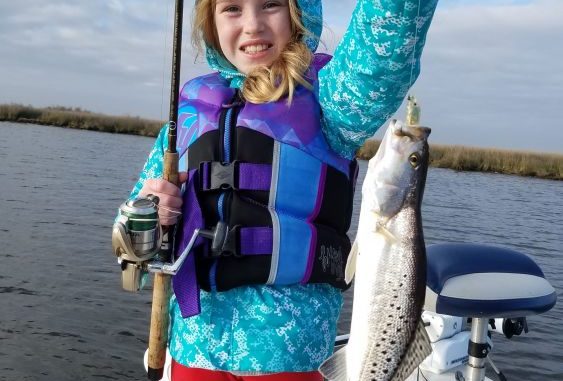
Warmer water target specks, cooler temps try for redfish
For February trips out of Dularge and Cocodrie, Capt. Tommy Pellegrin is a big believer in taking what the water temperature gives him.
“If it’s a cooler day and you get in your boat and look at your Lowrance and see 55 degrees or less, I would target redfish more,” said Pellegrin, with Custom Charters out of Houma. “If the water temperature is in the upper-50s, I would go looking for trout.
“That 55-degree mark is kind of the breaking point right there. Redfish don’t mind the cold as much as trout.”
If specks are what you’re after, Pellegrin said shrimp are long gone now, so he adjusts his soft plastic-presentation accordingly.
“They’ll still be schooled up in the interior, and depending on the weather and the bait, they’ll feed pretty good,” he said. “If it’s warmer and there’s a lot of bait, February is going to be all baitfish — not shrimp.
“So you’re going to be looking at sardine imitations, pogie imitations and those kinds of things to entice fish to bite.”
Two of his favorites for both specks and reds this month are Gulp’s Nemesis and Swimming Mullet on a ¼-ounce jighead, either tight-lined or under a popping cork. He likes the Nemesis in glitter pink, and the mullet in banana prawn.
“If you’re tight-lining on a colder day, just remember to move it very slow, just kind of crawling the bottom,” he said. “But on a warmer day, you can burn it up pretty good and you’ll still be catching.”
For February, Pellegrin suggested targeting specks and reds on the north end of Lake Mechant and nearby drains, the Deer Bayou area and the Bayou Severin area. Out of Cocodrie, he suggested Lake Boudreaux, Wonder Lake and Madison Bay.
He admitted it could be a tough month for specks depending on weather conditions, but described what he looked for in general when targeting wintertime trout.
“They need to be by deep water. They need to be by moving water — but not by water moving so fast that it’s cold and they have to fight it,” he said. “So you want a deep bayou with moving water that’s going to make a curve near a flat.”
If you’re tight-lining in deeper holes 12 to 18 feet down, he suggested stepping up to a ⅜-ounce jighead.
“Drop it down there and kind of bounce it real slow,” he said. “Just understand that the fish feeding during the wintertime don’t thump it real hard. It’s a very light bite.”


